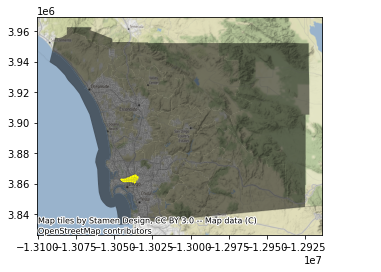San Diego Tracts
Contents
San Diego Tracts¶
This dataset contains an extract of a set of variables from the 2017 ACS Census Tracts for the San Diego (CA) metropolitan area.
import contextily
import geopandas
import cenpy
acs = cenpy.products.ACS(2017)
Download Data¶
Set variables to download
vars_to_download = {
"B25077_001E": "median_house_value", # Median house value
"B02001_002E": "total_pop_white", # Total white population
"B01003_001E": "total_pop", # Total population
"B25003_003E": "total_rented", # Total rented occupied
"B25001_001E": "total_housing_units", # Total housing units
"B09019_006E": "hh_female", # Female households
"B09019_001E": "hh_total", # Total households
"B15003_002E": "total_bachelor", # Total w/ Bachelor degree
"B25018_001E": "median_no_rooms", # Median number of rooms
"B19083_001E": "income_gini", # Gini index of income inequality
"B01002_001E": "median_age", # Median age
"B08303_001E": "tt_work", # Aggregate travel time to work
"B19013_001E": "median_hh_income" # Median household income
}
vars_to_download_l = list(vars_to_download.keys())
Download geometries and attributes
%%time
db = acs.from_msa("San Diego, CA",
level="tract",
variables=vars_to_download_l
)
/opt/conda/lib/python3.7/site-packages/pyproj/crs/crs.py:53: FutureWarning: '+init=<authority>:<code>' syntax is deprecated. '<authority>:<code>' is the preferred initialization method. When making the change, be mindful of axis order changes: https://pyproj4.github.io/pyproj/stable/gotchas.html#axis-order-changes-in-proj-6
return _prepare_from_string(" ".join(pjargs))
CPU times: user 1.12 s, sys: 153 ms, total: 1.27 s
Wall time: 30.8 s
Metadata¶
We will also write a companion file with the names of each variable:
var_names = acs.variables\
.reindex(vars_to_download)\
[["label", "concept"]]\
.reset_index()\
.rename(columns={"index": "var_id"})
var_names["short_name"] = var_names["var_id"].map(vars_to_download)
Process data¶
While the ACS comes with a large number of attributes, we are not limited to the original variables at hand; we can construct additional variables. This is particularly useful when we want to compare areas that are not very similar in some structural characteristic, such as area or population. For example, a quick look into the variable names shows most variables are counts. For tracts of different sizes, these variables will mainly reflect their overall population, rather than provide direct information about the variables itself. To get around this, we will cast many of these count variables to rates, and use them in addition to a subset of the original variables.
Replace missing values with columns mean
filler = lambda col: col.fillna(col.mean())
db.loc[:, vars_to_download] = db.loc[:, vars_to_download]\
.apply(filler)
Replace variable codes with short names
db = db.rename(columns=vars_to_download)
Calculate area in Sq.Km (we use the Conus Albers CRS)
db["area_sqm"] = db.to_crs(epsg=5070).area / 1e6
Percentage of renter occupied units
db["pct_rented"] = db["total_rented"] / \
(db["total_housing_units"] + \
(db["total_housing_units"]==0) * 1
)
Percentage of female households
db["pct_hh_female"] = db["hh_female"] / \
(db["hh_total"] + \
(db["hh_total"]==0) * 1
)
Percentage with a Bachelor’s degree
db["pct_bachelor"] = db["total_bachelor"] / \
(db["total_pop"] + \
(db["total_pop"]==0) * 1
)
Percentage of white population
db["pct_white"] = db["total_pop_white"] / \
(db["total_pop"] + \
(db["total_pop"]==0) * 1
)
Generate indicator for subset of contiguous 30 tracts
tract_geoids = [
'06073000100',
'06073000201',
'06073000202',
'06073000300',
'06073000400',
'06073000500',
'06073000600',
'06073000700',
'06073000800',
'06073000900',
'06073001000',
'06073001100',
'06073001200',
'06073001300',
'06073001400',
'06073001500',
'06073001600',
'06073001700',
'06073001800',
'06073001900',
'06073002001',
'06073002002',
'06073002100',
'06073002201',
'06073002202',
'06073002301',
'06073002302',
'06073002401',
'06073002402',
'06073002501'
]
db["sub_30"] = False
db.loc[db["GEOID"].isin(tract_geoids), "sub_30"] = True
ax = db.plot(alpha=0.5, color="k")
db[db["sub_30"]].plot(ax=ax, color="yellow")
contextily.add_basemap(ax, crs=db.crs);

Write Out¶
db.info()
<class 'geopandas.geodataframe.GeoDataFrame'>
Int64Index: 628 entries, 0 to 627
Data columns (total 25 columns):
# Column Non-Null Count Dtype
--- ------ -------------- -----
0 GEOID 628 non-null object
1 geometry 628 non-null geometry
2 median_age 628 non-null float64
3 total_pop 628 non-null float64
4 total_pop_white 628 non-null float64
5 tt_work 628 non-null float64
6 hh_total 628 non-null float64
7 hh_female 628 non-null float64
8 total_bachelor 628 non-null float64
9 median_hh_income 628 non-null float64
10 income_gini 628 non-null float64
11 total_housing_units 628 non-null float64
12 total_rented 628 non-null float64
13 median_no_rooms 628 non-null float64
14 median_house_value 628 non-null float64
15 NAME 628 non-null object
16 state 628 non-null object
17 county 628 non-null object
18 tract 628 non-null object
19 area_sqm 628 non-null float64
20 pct_rented 628 non-null float64
21 pct_hh_female 628 non-null float64
22 pct_bachelor 628 non-null float64
23 pct_white 628 non-null float64
24 sub_30 628 non-null bool
dtypes: bool(1), float64(18), geometry(1), object(5)
memory usage: 123.3+ KB
Dataset
! rm -f sandiego_tracts.gpkg
db.to_file("sandiego_tracts.gpkg", driver="GPKG")
Metadata
! rm -f sandiego_tracts_varnames.json
var_names.to_json("sandiego_tracts_varnames.json")
